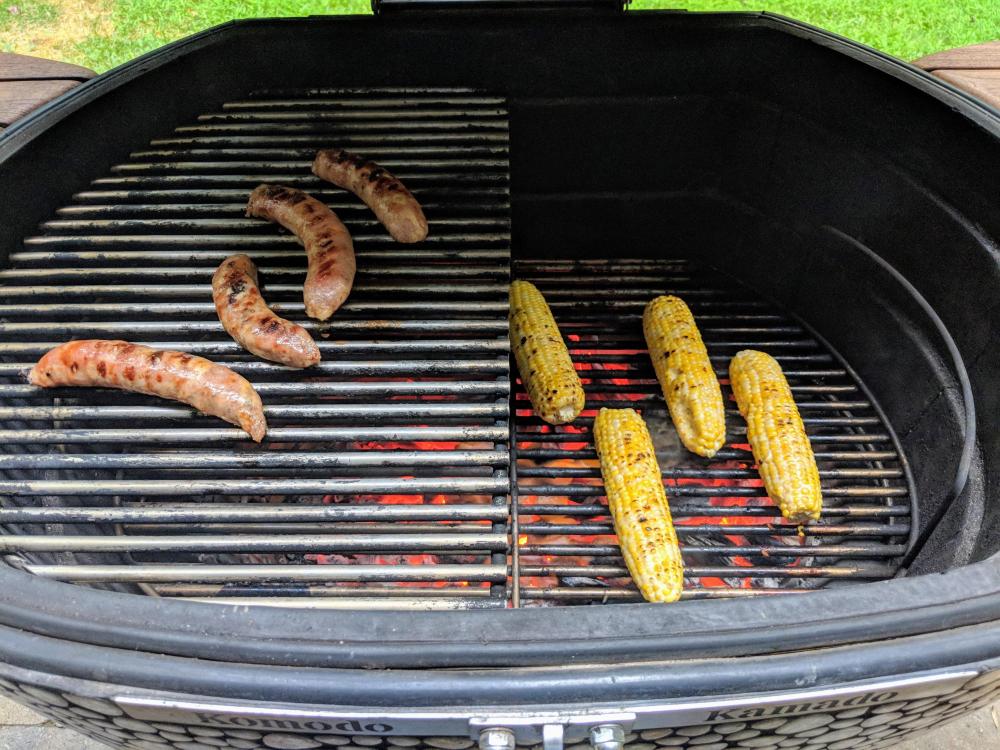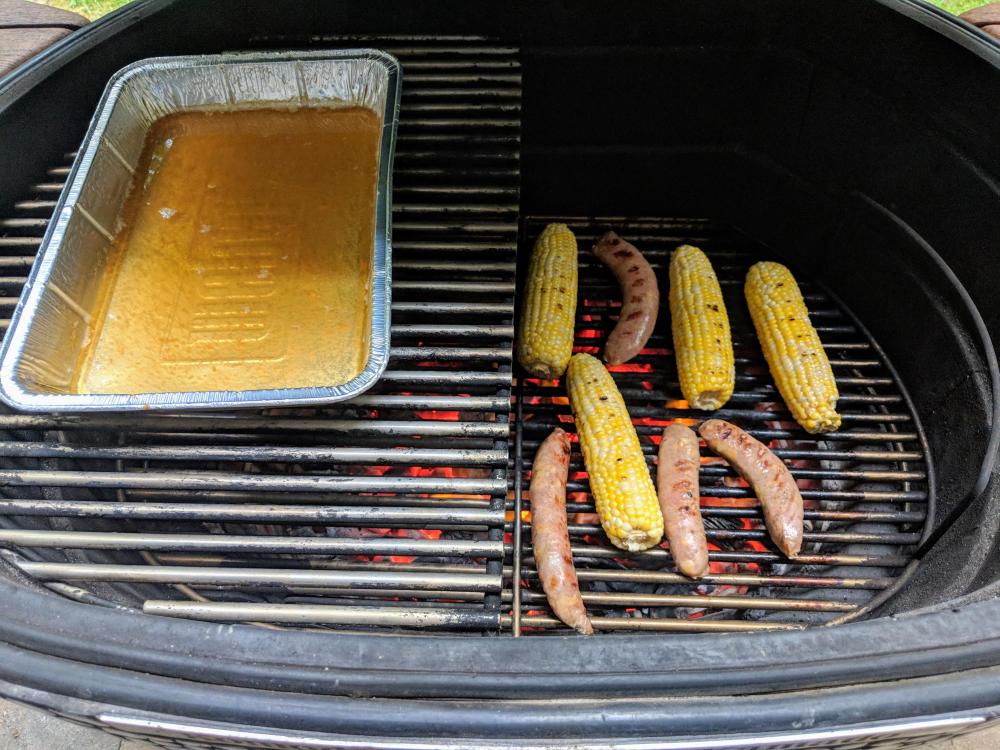-
Posts
2,682 -
Joined
-
Last visited
-
Days Won
98
Content Type
Profiles
Forums
Events
Everything posted by Pequod
-
...and here I was expecting to FINALLY learn how to cook flamingo.
-

Blueberry BBQ Sauce - suitable for canning.
Pequod replied to ckreef's topic in Sauces, Mops, Sops, Bastes, Marinades & Rubs
Finally got around to using this with some pulled pork tonight. My daughter the food critic and I both agreed it was excellent. Great stuff! -
I did similar research earlier this year to figure out why the pellets I used (from amazn tube smokers) left so much gunk in the cold smoker. Those mystery pellets are junk. I ended up with cookinpellets.com. Much better.
-
Homemade dough can and should be considerably better than store bought. Even simple, no knead 72 hour doughs will produce fantastic results with very little effort. More advanced techniques produce even better results. Hard to go back once you’ve experienced those. My advice would be to start with something simple like the@ckreef artisan pizza dough tutorial and compare that with your bakery dough. Sent from my iPad using Tapatalk
-

Forum's acting squirrely today
Pequod replied to tony b's topic in Forum Suggestions, Issues and Enhancements
Still squirrely here. Haven’t been able to log in via the web. Had to install Tapatalk just to type this (more as a test of the emergency Tapatalk system than anything else). Sent from my iPad using Tapatalk -
Darn. You beat me to it. I was going to tell him you’ve been posting Konro cooks weekly since January.
-
Ah...the joy and wonder of true two-zone grilling on display. Didn't even use the basket splitter. Just piled the lump to the side, letting distance squared do it’s thing. Simmered the brats in beer on the indirect side, then onto the direct sear with some corn. All done with the flick of a wrist and some tongs. Brats are done! Back to the indirect side to stay warm whilst the corn cooks direct for awhile longer. No grates were moved. Just some more magic with tongs.
-
Another great plate. Can’t wait to get my Konro. Although, since my wife likes fondue so much, I’m thinking the Konro is for her. Yeah...that’s it...can't wait to give her the Konro!
-
@tekobo - Here's Meathead's take on the subject: https://amazingribs.com/more-technique-and-science/grill-and-smoker-setup-and-firing/how-control-temperature-indirect Note that he refers to the two zones as "convection" and "radiant" heat zones. In reality both forms of heat transfer are present throughout. What he really means is that on the indirect side, convective heat transfer dominates over radiant, while the opposite is true on the direct side. Getting the radiant below a threshold is what my post above was all about. To your point, what you suggested should work fine. I still want to do the test with the XR50.
-
I agree. I think the hassle of moving food and grates around to get to the "sear zone" is why I don't think of the 23 as a true two-zone grill and don't use mine for that. It isn't as convenient as simply moving food to the hot side. A half-grate for the 23" -- even as an add-on accessory -- would go a long way.
-
Probably 80% is straight charcoal. Add wood to the rest. Charcoal I like: KK Coffeewood lump, KK CoCo char, Rockwood lump Wood: Whatever suits the cook.
-
I’ll get a little technical for a moment, but I know @tony b is a recovering engineer, so let’s roll with some Engineering approximations and others feel free to ignore. (Once an engineer, always an engineer!). Radiation decays with distance squared. So, in a Weber, where the distance from the coals on the direct side is, say 6”, and distance on the indirect side is say, an average of 18”, the radiative heat transfer rate is nearly 10 times less on the indirect side vs the direct. Do the same math for the grates of a 23”, where the main is about 18” from the fire, the middle grate is about 12”, and the sear grate is 6”. For the main grate, the distance to the fire is about 18” on the direct side, and (doing a little Pythagorean thing), about 22” to the middle of the indirect side. Repeat this for each grate. Here are the results: Main grate: Radiative heat transfer on the indirect side is about 2/3 that on the direct side Mid grate: indirect side is about 1/2 that of direct Sear grate: indirect is 1/5 of direct Comparison between main grate indirect and sear grate direct: about 1/13 of direct I’ll skip directly to the results for the 32: Main grate: indirect side is 1/2 of direct Mid grate: indirect side is 1/3 of direct Sear grate: indirect side is 1/8 of direct Another data point comparing indirect side main grate to direct side sear grate (I.e., the 32’s two-zone configuration): 1/16 of direct Last, take a closer look at Dennis’ video. First, that’s the mid grate of a 23. Per calcs above, radiative heat transfer on indirect side is about 1/2 the direct side. Notice something else? The paper is browning fastest from conductive heat transfer via the grate itself, not radiative, which is why we go to the direct side (unless using conduction via a steel of CI to sear). What does all of this mean? The definition of “two-zone” is somewhat subjective, but it starts with a differential in radiative heat transfer between two sides of a grill. Let’s say the magic ratio of indirect:direct is 1:10. The Weber achieves this. A high (indirect)/low (direct) 23 and 32 both do this. The difference, then, is in the convenience and grilling area for the indirect and direct sides. For the 23, you have to remove the food and the main grate to get to the sear grate. For the 32, you simply flip from the main half-grate to the sear grate without moving anything. For a Weber, same thing...flip to the direct side or use the cold grill technique. A concluding comment: in my subjective opinion, the reason I say the 32 is a true two zone grill and the 23 isn’t comes down to convenience for two zone grilling. With the 32, I can complete a two-zone cook without ever moving any grates and without ever worrying about having enough room. The 32 is a two-zone machine.
-
I take off the air tube too. Reason is that “gunk” (technical term...look it up) tends to accumulate in there. After the PBW, I run a long metal skewer inside to remove it.
-
Bruce, the Bazaar Spice suya pepper is excellent, and very similar to @tekobo's Nigerian suya pepper. You won't be disappointed.
-
Interesting. I'll amend my statement to: The 32 and 42 have two BIG zones. Big enough for a goat. A good, and not so hard to do experiment, would be to put a 23, 32, and 42 in split (50/50) basket configuration and place a grate level probe at the midway point of each half on the main grate. Dial in so that the indirect side is the same on each -- say 250F. What is the reading of the direct side probe? Or flip it around -- dial in 450 on the direct side of each; what is the reading on the indirect side? My intuition says the temperature differential between direct and indirect sides is greatest with the 42, then 32, then 23, but by how much? With my Maverick XR50, I could get readings at four points on the main grate of my 23 and 32, but somebody would have to send me a 42 to measure that.
-
Beautiful! Dennis will be along soon to ask you for a pic with the cap on in its final location for Instagram.
-
I do the same. Just habit now. Soak the cold smoker in PBW and reassemble. Good to go next day.
-
What it means is that the size and shape of the 32 relative to the 23 lends itself to a substantial temperature differential between the hot and cool sides, and with substantial area for both. So, imagine each is in a configuration with the basket splitter (the 32 in 50/50 configuration...it can also do 75/25). At the sear grate level, the indirect vs. direct sides are roughly equivalent temperature-wise. The biggest difference is the very small direct area due to basket size. Now move your eyeline to the upper grate. Here you have a full size 23" main grate over a split basket. The difference in temp between the hot side and cool side is much less here. There's no reason to cook this way. In a 32", I'm using a half main grate and the temperature differential is still high due to distance. Now for workflow. Let's say we're reverse searing some steaks. In the 23, I have no reason to use a split basket, because I'll just cook the steaks at low (225'ish) temp on the main grate until they're "in the zone", remove the steaks and main grate, crank the vents, wait for a roaring flame, then sear. All's good, if a bit complex. Here's the same workflow for the 32. Cook the steaks on the cool side until they're in the zone, then flip them directly onto the sear grate. Done.
-
Yes! Do tell! Can’t wait to get my Konro. Wife will be surprised and pleased that I’ve covered my own Christmas shopping again.
-
Not quite true. The 32 and 42 are true two-zone grills. The others aren’t.
-
Your next step is to call Dennis and have this conversation with him. You’ll not get a hard sell. He’ll work with you to make sure you’re getting what fits you best. We’re here too. But Dennis is the man!
-
Given that, a 23 with baking stone might suit you fine. Besides capacity, the biggest difference between the two is that the 32 is a true two-zone grill and the 23 isn’t. I typically leave my 32 in two zone configuration. In your case...I’m thinking 23 would do you very well.
-
Ditto the above. If anything, you’ll have to unlearn the tendency to play with the vents. Regarding size, I have both a 23 and a 32. The 32 is better all around. Period. That said, what’s your cooking style? Mostly low and slow? Lots of grilling? Baking? Pizza? Rotisserie? What’s the largest group you’d cook for?
-
I admit, I do sometimes wonder whether the prince succeeded in finding a new home for his stash and who he shared that fortune with. I also have concerns for what happens to Santa’s elves in January.
-
I had some posts on hot smoking with this thing when it first came out. Not gonna look them up and force them on you, but summarizing key points: Both give you clean smoke. Temp range: smoke pot is at its best from 225-275F. Cold smoker has no limits. Smoke intensity: cold smoker is controllable throughout the cook. Smoke pot is set, forget, and accept what it gives you. Smoke duration: Unlimited with cold smoker because you can refill anytime. About 4 hours with the smoke pot. Ease of use: Smoke pot is dead simple. Cold smoker requires power, tubes, attachments, etc. (but worth the minimal hassle). Both have their place, but the cold smoker is super versatile.







